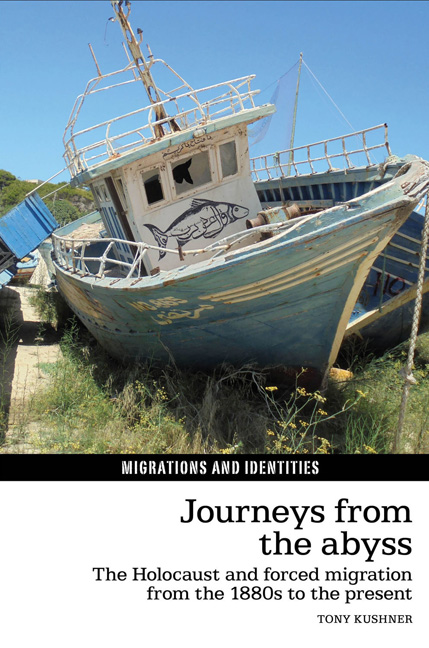Book contents
- Frontmatter
- Dedication
- Contents
- Preface and Acknowledgments
- Introduction: Migration and the Holocaust
- Part 1 Gender, Forced Migration, and Testimony: From ‘White Slavery’ to ‘Trafficking’ via Refugee Domestic Servants
- Part 2 Place, Performance, and Legality: Holocaust Survivors and Other Migrant Journeys in the Long Twentieth Century
- Chapter 3 The Journeys of Child Refugees, Lost and Rediscovered
- Chapter 4 The Ship and the Battle over Migrant ‘Illegality’
- Conclusion
- Bibliography
- Index
Chapter 4 - The Ship and the Battle over Migrant ‘Illegality’
from Part 2 - Place, Performance, and Legality: Holocaust Survivors and Other Migrant Journeys in the Long Twentieth Century
- Frontmatter
- Dedication
- Contents
- Preface and Acknowledgments
- Introduction: Migration and the Holocaust
- Part 1 Gender, Forced Migration, and Testimony: From ‘White Slavery’ to ‘Trafficking’ via Refugee Domestic Servants
- Part 2 Place, Performance, and Legality: Holocaust Survivors and Other Migrant Journeys in the Long Twentieth Century
- Chapter 3 The Journeys of Child Refugees, Lost and Rediscovered
- Chapter 4 The Ship and the Battle over Migrant ‘Illegality’
- Conclusion
- Bibliography
- Index
Summary
Space, Illegality, and Naming
How long have immigrants been labelled ‘illegal’? To reappropriate Martin Luther King's words in Montgomery, Alabama: ‘How long? Not long.’ The slogan ‘no one is illegal’ has been taken up by pro-migrant groups, especially those campaigning on behalf of asylum-seekers and others detained or awaiting deportation in the West. It is used to highlight the common humanity of those placed beyond the law with regard to their national/ international status. In this respect, the children's character Paddington Bear, who came to England as a stowaway on board a ship from ‘Darkest Peru’, has become ‘amongst immigration lawyers a walking, talking, ursine pin-up for humanising our work’. Yet had Paddington (who arrived in the London docks in the 1950s) come just half a century earlier, he would have had no need to enter as an ‘illegal immigrant’. Indeed, until the late nineteenth century onwards (and especially since the First World War), the introduction of border controls, with concomitant legislation and state bureaucracy, linking the act of migration with legal legitimacy was largely unthinkable. If the idea of ‘open borders’ is now regarded as utopian (or dystopian, from a restrictionist's perspective), for the vast majority of human history it has been the natural order of the world.
In her Excitable Speech: A Politics of the Performative, Judith Butler refers to the ‘jarring, even terrible, power of naming … the power of the name to inaugurate and sustain linguistic existence, to confer singularity in location and time’. It is ‘the vulnerability to being named [which] constitutes a constant condition of the speaking subject’. Butler adds with regard to ‘hate speech’ that
Clearly, injurious names have a history, one that is invoked and reconsolidated at the moment of utterance … The name has … a historicity, what might be understood as the history which has become internal to a name, has come to constitute the contemporary meaning of a name.
It is the ‘sedimentation of its usages … a repetition that congeals, that gives the name its force’.
In the case of ‘illegal immigration’ or ‘illegal immigrants’, the terminology is relatively new – it came into bureaucratic use during the 1930s. Once coined, however, it developed its own life beyond the time and place of its origins, thereafter gaining momentum.
- Type
- Chapter
- Information
- Journeys from the AbyssThe Holocaust and Forced Migration from the 1880s to the Present, pp. 223 - 304Publisher: Liverpool University PressPrint publication year: 2017

